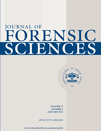Experimental and Casework Validation of Ambient Temperature Corrections in Forensic Entomology* ,†
Presented in part at the 23rd International Congress of Entomology, July 6–12, 2008, in Durban, South Africa; and in part at the 20th International Symposium on the Forensic Sciences (ANZFSS) September 5–9, 2010, in Sydney, Australia.
Financial support provided by the Australian Federal Police and the University of Wollongong.
Abstract
Abstract: This paper expands on Archer (J Forensic Sci 49, 2004, 553), examining additional factors affecting ambient temperature correction of weather station data in forensic entomology. Sixteen hypothetical body discovery sites (BDSs) in Victoria and New South Wales (Australia), both in autumn and in summer, were compared to test whether the accuracy of correlation was affected by (i) length of correlation period; (ii) distance between BDS and weather station; and (iii) periodicity of ambient temperature measurements. The accuracy of correlations in data sets from real Victorian and NSW forensic entomology cases was also examined. Correlations increased weather data accuracy in all experiments, but significant differences in accuracy were found only between periodicity treatments. We found that a >5°C difference between average values of body in situ and correlation period weather station data was predictive of correlations that decreased the accuracy of ambient temperatures estimated using correlation. Practitioners should inspect their weather data sets for such differences.




